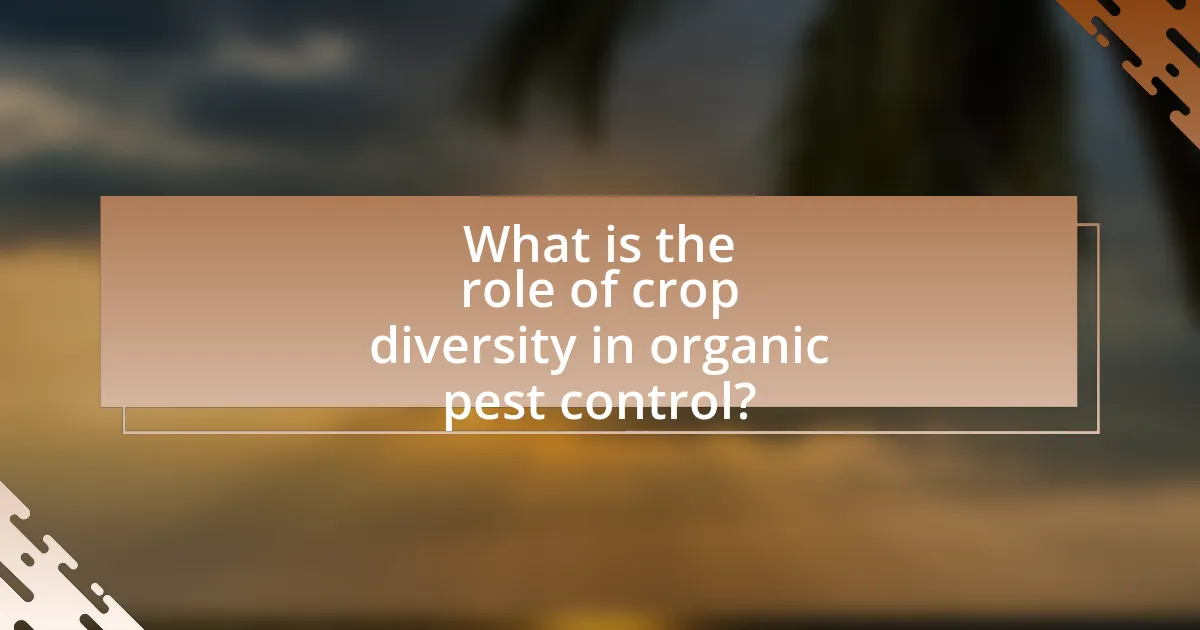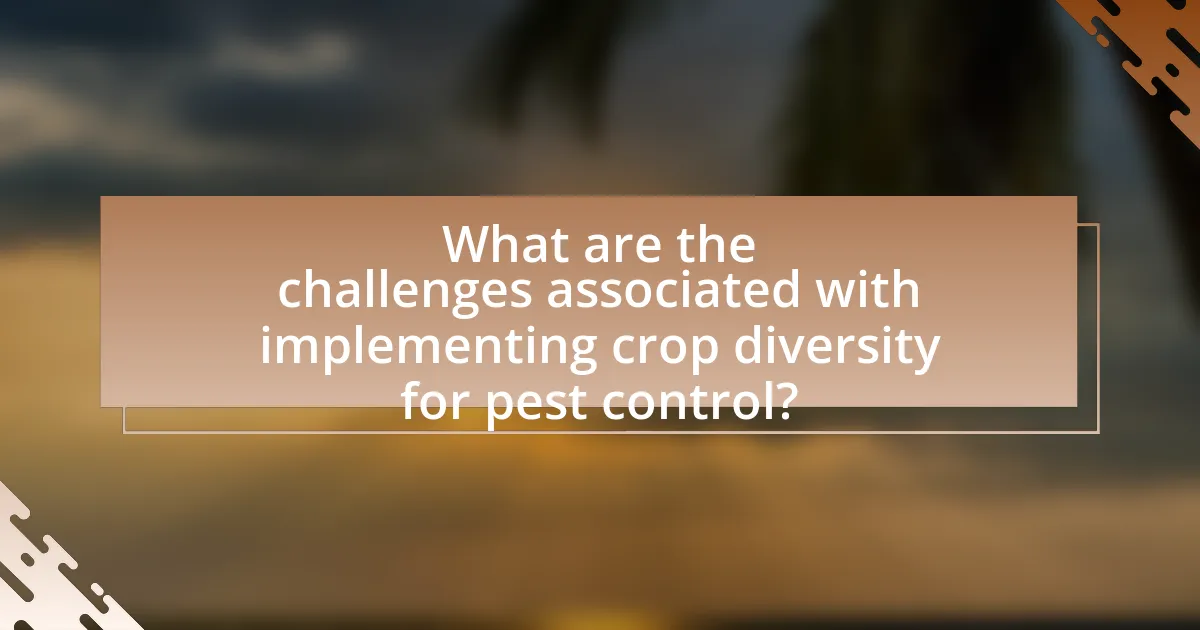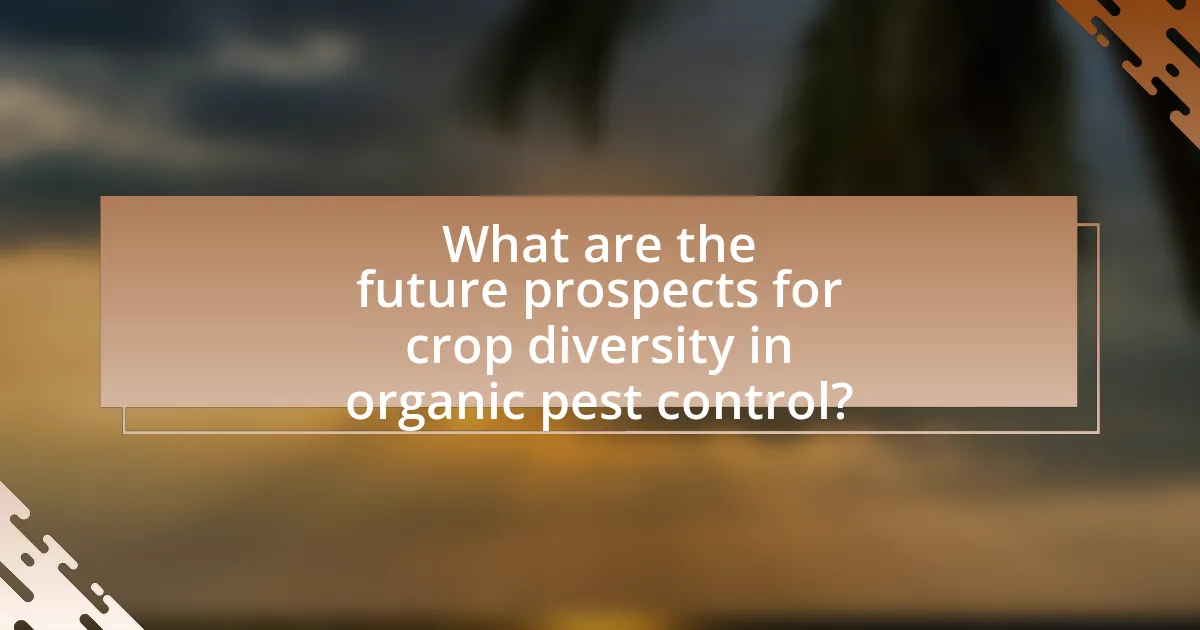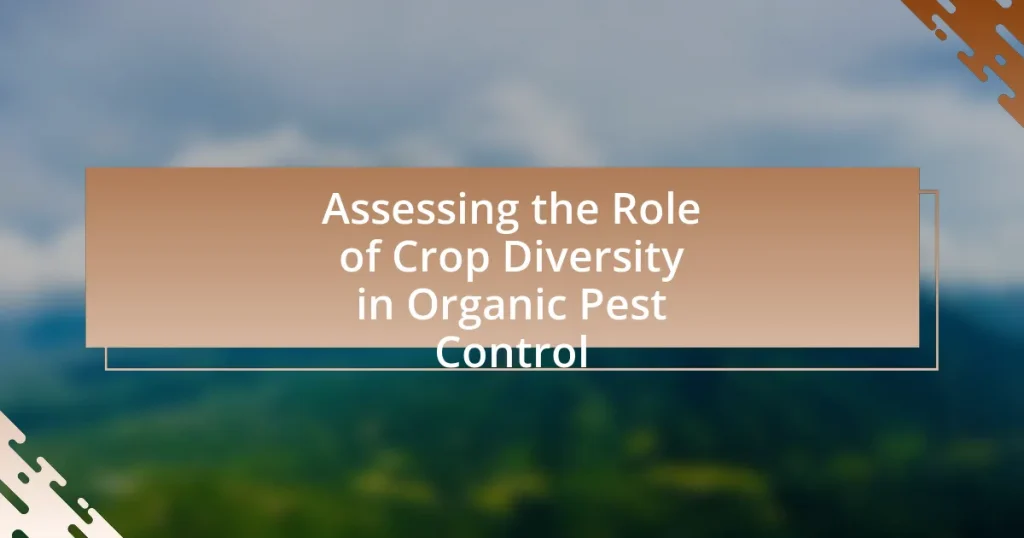The article focuses on the critical role of crop diversity in organic pest control, highlighting its ability to enhance ecosystem resilience and promote natural pest regulation. It discusses how diverse cropping systems create habitats for beneficial organisms that manage pest populations, leading to lower pest incidence and outbreaks. Key mechanisms of pest suppression through crop diversity, such as habitat diversification and enhanced natural enemy populations, are examined, along with the ecological benefits and challenges associated with implementing diverse cropping systems. The article also addresses the economic factors influencing farmers’ decisions to diversify crops and provides practical tips for maximizing the benefits of crop diversity in pest management.

What is the role of crop diversity in organic pest control?
Crop diversity plays a crucial role in organic pest control by enhancing ecosystem resilience and promoting natural pest regulation. Diverse cropping systems create habitats for beneficial organisms, such as predators and parasitoids, which help manage pest populations. Research indicates that farms with higher crop diversity experience lower pest incidence due to the presence of these natural enemies, as well as reduced pest outbreaks. For example, a study published in the journal “Agriculture, Ecosystems & Environment” found that polycultures can significantly decrease pest density compared to monocultures, demonstrating the effectiveness of crop diversity in sustainable pest management.
How does crop diversity contribute to pest management in organic farming?
Crop diversity significantly enhances pest management in organic farming by disrupting pest life cycles and promoting beneficial organisms. When multiple crop species are cultivated together, it creates a varied habitat that can deter pests, as many pests are specialized to specific crops. Research indicates that polycultures can reduce pest populations by up to 50% compared to monocultures, as seen in studies conducted by the University of California, which found that diverse plantings attract natural predators and parasitoids that help control pest populations. Additionally, crop diversity can lead to improved soil health and resilience, further supporting sustainable pest management practices.
What specific mechanisms are involved in pest suppression through crop diversity?
Crop diversity suppresses pests through several specific mechanisms, including habitat diversification, enhanced natural enemy populations, and reduced pest establishment. Habitat diversification occurs as varied crops create microhabitats that support a wider range of beneficial organisms, which can prey on or parasitize pests. Enhanced natural enemy populations result from the presence of diverse crops that provide food and shelter for predators and parasitoids, leading to increased biological control. Additionally, reduced pest establishment is facilitated by crop rotation and intercropping, which disrupt pest life cycles and lower their chances of survival and reproduction. Studies have shown that farms with higher crop diversity often experience lower pest densities, demonstrating the effectiveness of these mechanisms in organic pest control.
How does crop diversity influence pest populations and their natural enemies?
Crop diversity significantly reduces pest populations and enhances the presence of their natural enemies. This occurs because a variety of crops can disrupt the life cycles of pests, making it harder for them to establish and proliferate. For instance, studies have shown that polyculture systems, where multiple crop species are grown together, can lead to lower pest densities compared to monocultures. Research published in “Ecological Applications” by Letourneau et al. (2011) indicates that diverse cropping systems can increase the abundance and diversity of beneficial insects, such as predators and parasitoids, which help control pest populations. Thus, crop diversity not only mitigates pest outbreaks but also fosters a more robust ecosystem of natural pest control agents.
Why is crop diversity important for sustainable agriculture?
Crop diversity is important for sustainable agriculture because it enhances ecosystem resilience and reduces dependency on chemical inputs. Diverse crops can improve soil health, promote beneficial insect populations, and disrupt pest cycles, leading to lower pest infestations. Research indicates that farms with higher crop diversity can reduce pesticide use by up to 50%, as diverse plantings attract natural predators of pests and create habitats that support beneficial organisms. This ecological balance not only supports sustainable farming practices but also contributes to food security and biodiversity conservation.
What ecological benefits does crop diversity provide in organic systems?
Crop diversity in organic systems enhances ecological resilience and pest control. By cultivating a variety of crops, organic systems promote beneficial interactions among plants, insects, and soil organisms, which can lead to improved pest management. For instance, diverse cropping systems can disrupt pest life cycles and reduce the prevalence of specific pests, as seen in studies where polycultures significantly lowered pest populations compared to monocultures. Additionally, crop diversity supports a wider range of beneficial organisms, such as pollinators and natural predators, which contribute to ecosystem stability and productivity. Research indicates that farms with higher crop diversity exhibit greater soil health and nutrient cycling, further reinforcing the ecological benefits of diverse cropping practices in organic agriculture.
How does crop diversity enhance soil health and resilience?
Crop diversity enhances soil health and resilience by promoting a variety of root structures and microbial communities that improve soil structure and nutrient cycling. Different crops contribute unique organic matter and root exudates, which foster beneficial microorganisms, enhance soil fertility, and reduce erosion. Research indicates that diverse cropping systems can increase soil organic carbon levels by up to 30%, leading to improved water retention and nutrient availability. This diversity also helps in pest and disease management, as varied plant species can disrupt pest life cycles and reduce reliance on chemical inputs, further contributing to soil health.

What are the challenges associated with implementing crop diversity for pest control?
Implementing crop diversity for pest control faces several challenges, including the complexity of managing diverse cropping systems, potential yield reductions, and the need for specialized knowledge. The complexity arises from the requirement to coordinate different planting schedules, crop rotations, and pest management strategies, which can overwhelm farmers accustomed to monoculture practices. Additionally, studies indicate that transitioning to diverse systems may initially lead to lower yields as ecosystems stabilize, creating economic pressure on farmers. Furthermore, effective implementation requires a deep understanding of ecological interactions, pest dynamics, and local conditions, which may not be readily available to all farmers. These challenges can hinder the widespread adoption of crop diversity as a pest control strategy.
What barriers do farmers face in adopting diverse cropping systems?
Farmers face several barriers in adopting diverse cropping systems, including economic constraints, lack of knowledge, and limited access to resources. Economic constraints arise from the initial investment required for diverse crops, which can be higher than monoculture systems. Lack of knowledge about the benefits and management of diverse cropping systems can hinder farmers from making informed decisions. Additionally, limited access to seeds, technology, and markets for diverse crops further complicates the transition. Research indicates that these barriers can significantly impact the willingness of farmers to diversify their cropping practices, ultimately affecting their productivity and sustainability.
How do economic factors influence the decision to diversify crops?
Economic factors significantly influence the decision to diversify crops by affecting farmers’ profitability and risk management strategies. When market prices for certain crops fluctuate, farmers may choose to diversify their crop production to stabilize income and reduce dependency on a single crop. For instance, a study by the Food and Agriculture Organization (FAO) indicates that crop diversification can lead to a 20% increase in farm income by mitigating risks associated with price volatility and crop failure. Additionally, access to credit and investment in agricultural technology can incentivize farmers to diversify, as they seek to maximize returns on investment and improve resilience against economic downturns.
What knowledge gaps exist regarding crop diversity and pest control?
Knowledge gaps regarding crop diversity and pest control include insufficient understanding of the specific mechanisms through which diverse cropping systems influence pest dynamics. Research indicates that while crop diversity can enhance pest control by promoting beneficial organisms, the exact relationships and interactions remain poorly defined. For instance, studies have shown that certain plant combinations can attract natural predators of pests, yet the optimal diversity levels and specific plant pairings for effective pest management are not well established. Additionally, there is limited data on the long-term effects of crop diversity on pest populations and ecosystem health, which hinders the development of comprehensive pest management strategies.
How can farmers effectively integrate crop diversity into their pest management strategies?
Farmers can effectively integrate crop diversity into their pest management strategies by implementing polyculture systems, which involve growing multiple crop species in proximity. This approach enhances ecosystem resilience, disrupts pest life cycles, and promotes beneficial insect populations. Research indicates that diverse cropping systems can reduce pest populations by up to 50% compared to monocultures, as demonstrated in studies conducted by the University of California, Davis, which found that intercropping can significantly lower pest incidence and improve crop yields. By strategically selecting complementary crops, farmers can create habitats that attract natural predators, further enhancing pest control without relying on chemical pesticides.
What best practices should be followed for successful crop diversification?
Successful crop diversification involves implementing practices such as selecting complementary crops, rotating crops to enhance soil health, and integrating pest management strategies. Complementary crops can improve nutrient utilization and reduce pest populations, as seen in studies where intercropping legumes with cereals led to lower pest incidence. Crop rotation helps break pest and disease cycles, promoting healthier ecosystems; for instance, rotating corn with soybeans has been shown to reduce rootworm populations. Additionally, incorporating organic pest control methods, such as beneficial insects and natural repellents, further enhances the effectiveness of diversified cropping systems. These practices collectively contribute to sustainable agricultural systems and improved pest management.
How can farmers monitor and evaluate the effectiveness of crop diversity in pest control?
Farmers can monitor and evaluate the effectiveness of crop diversity in pest control by implementing integrated pest management (IPM) strategies that include regular pest population assessments and crop health evaluations. By conducting systematic observations and recording pest incidence and damage levels across diverse crop varieties, farmers can identify which combinations of crops provide the best natural pest suppression. Research indicates that polycultures can reduce pest populations by up to 50% compared to monocultures, as diverse plantings disrupt pest life cycles and enhance beneficial insect activity. Additionally, farmers can utilize tools such as pheromone traps and visual inspections to gather data on pest dynamics, allowing for informed decisions on crop management practices.

What are the future prospects for crop diversity in organic pest control?
The future prospects for crop diversity in organic pest control are promising, as increased biodiversity can enhance ecosystem resilience and improve pest management strategies. Research indicates that diverse cropping systems can disrupt pest life cycles and reduce pest populations through natural predation and competition. For instance, a study published in the journal “Agriculture, Ecosystems & Environment” by Letourneau et al. (2011) found that polyculture systems significantly reduced pest abundance compared to monocultures. This evidence supports the notion that integrating a variety of crops can lead to more sustainable organic farming practices, ultimately benefiting pest control efforts.
How is research advancing our understanding of crop diversity’s role in pest management?
Research is advancing our understanding of crop diversity’s role in pest management by demonstrating that diverse cropping systems can enhance ecosystem resilience and reduce pest populations. Studies have shown that increased crop diversity disrupts pest life cycles and promotes beneficial organisms, leading to natural pest control. For instance, a meta-analysis published in “Ecological Applications” by Cardinale et al. (2011) found that higher plant diversity significantly reduced pest abundance and increased crop yields. This evidence supports the notion that integrating diverse crops can be a sustainable strategy for managing pests in agricultural systems.
What innovative practices are being developed to enhance crop diversity in organic farming?
Innovative practices being developed to enhance crop diversity in organic farming include intercropping, cover cropping, and the use of diverse seed varieties. Intercropping involves planting multiple crop species in proximity to promote biodiversity, which can lead to improved pest control and soil health. Cover cropping, where non-cash crops are grown during off-seasons, enhances soil fertility and suppresses weeds, contributing to a more diverse ecosystem. Additionally, the introduction of diverse seed varieties, including heirloom and native species, supports resilience against pests and diseases. Research indicates that these practices can significantly improve ecosystem services, as demonstrated in studies showing increased yields and reduced pest populations in diverse cropping systems.
How can technology support the implementation of crop diversity for pest control?
Technology can support the implementation of crop diversity for pest control by utilizing precision agriculture tools, such as remote sensing and data analytics, to optimize crop selection and management. These technologies enable farmers to analyze soil health, pest populations, and environmental conditions, allowing for informed decisions on which diverse crops to plant that can naturally deter pests. For instance, studies have shown that intercropping systems, where different crops are grown together, can reduce pest incidence by up to 50% compared to monocultures. Additionally, mobile applications and software platforms can provide real-time data on pest outbreaks, helping farmers to adapt their crop diversity strategies promptly.
What practical tips can farmers use to maximize the benefits of crop diversity in pest control?
Farmers can maximize the benefits of crop diversity in pest control by implementing intercropping, which involves growing different crops in proximity. This practice disrupts pest life cycles and reduces their populations, as diverse plant species can attract beneficial insects that prey on pests. Research indicates that intercropping can lead to a 30-50% reduction in pest damage compared to monoculture systems. Additionally, farmers should rotate crops annually to prevent pest adaptation and build soil health, which further supports pest resilience. Studies show that crop rotation can decrease pest incidence by up to 70%, enhancing overall crop productivity and sustainability.
How can farmers select the right crops for effective pest management?
Farmers can select the right crops for effective pest management by choosing diverse crop varieties that enhance ecological balance and disrupt pest life cycles. Crop diversity reduces the prevalence of specific pests by providing habitats for beneficial insects and promoting natural pest predators. Research indicates that polyculture systems, where multiple crops are grown together, can lead to a 50% reduction in pest populations compared to monoculture systems. Additionally, selecting crops that are resistant to local pests can further minimize pest damage and reliance on chemical controls.
What resources are available to assist farmers in implementing crop diversity strategies?
Farmers can access various resources to implement crop diversity strategies, including agricultural extension services, research institutions, and online platforms. Agricultural extension services provide localized advice and training on crop diversity practices, while research institutions, such as universities and agricultural colleges, offer studies and publications that detail successful crop diversity methods. Online platforms, like the Sustainable Agriculture Research and Education (SARE) program, provide comprehensive guides and case studies that demonstrate the benefits and techniques of crop diversity in pest control. These resources collectively support farmers in enhancing biodiversity on their farms, which is crucial for effective organic pest management.










